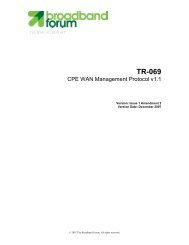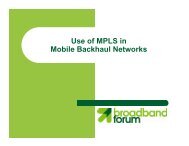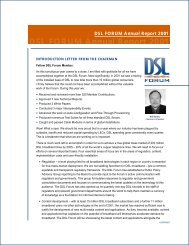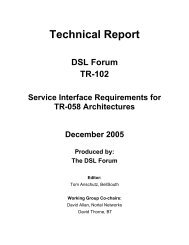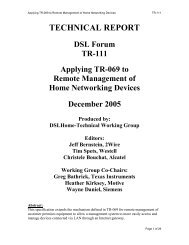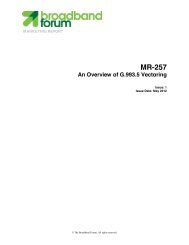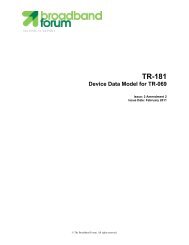MPLS in Mobile Backhaul Networks Framework and Requirements ...
MPLS in Mobile Backhaul Networks Framework and Requirements ...
MPLS in Mobile Backhaul Networks Framework and Requirements ...
You also want an ePaper? Increase the reach of your titles
YUMPU automatically turns print PDFs into web optimized ePapers that Google loves.
<strong>MPLS</strong> <strong>in</strong> <strong>Mobile</strong> <strong>Backhaul</strong> <strong>Networks</strong> <strong>Framework</strong> <strong>and</strong> <strong>Requirements</strong> Technical Specification IP/<strong>MPLS</strong> Forum 20.0.0<br />
________________________________________________________________________________________________________<br />
Table of Contents<br />
1 INTRODUCTION ...............................................................................................................................................7<br />
1.1 PURPOSE ............................................................................................................................................................7<br />
1.2 OVERVIEW.........................................................................................................................................................7<br />
1.2.1 Motivation.........................................................................................................................................................7<br />
1.3 SCOPE ................................................................................................................................................................8<br />
1.3.1 RAN Topology Differences..............................................................................................................................9<br />
2 DEFINITIONS...................................................................................................................................................11<br />
3 ACRONYMS......................................................................................................................................................11<br />
4.1 NORMATIVE REFERENCES ........................................................................................................................13<br />
4.2 INFORMATIVE REFERENCES ....................................................................................................................14<br />
5 REFERENCE ARCHITECTURE FOR CENTRALIZED MOBILE NETWORKS..................................15<br />
5.1 TNL SCENARIOS FOR <strong>MPLS</strong> IN CENTRALIZED MOBILE NETWORKS..................................................................16<br />
5.2 <strong>MPLS</strong> USE CASES IN CENTRALIZED MOBILE NETWORKS...................................................................................17<br />
5.2.1 TNL encapsulation..........................................................................................................................................18<br />
6 REFERENCE ARCHITECTURE FOR FLAT MOBILE NETWORKS ....................................................26<br />
6.1 L2VPN <strong>MPLS</strong> USE CASES ...............................................................................................................................27<br />
6.2 L3VPN <strong>MPLS</strong> USE CASES ...............................................................................................................................27<br />
6.3 IP TNL SCENARIO ...........................................................................................................................................28<br />
7 GENERIC REQUIREMENTS FOR <strong>MPLS</strong> BACKHAUL TRANSPORT NETWORK............................30<br />
7.1 Encapsulation requirements ............................................................................................................................30<br />
7.2 <strong>MPLS</strong> Network Signal<strong>in</strong>g <strong>Requirements</strong> for PWs <strong>and</strong> LSPs .........................................................................31<br />
7.3 <strong>MPLS</strong> Network Signal<strong>in</strong>g <strong>Requirements</strong> for VPLS <strong>and</strong> L3VPNs..................................................................31<br />
7.4 OAM ...............................................................................................................................................................31<br />
7.5 Traffic Eng<strong>in</strong>eer<strong>in</strong>g <strong>and</strong> QoS <strong>Requirements</strong>...................................................................................................32<br />
7.6 Protection ........................................................................................................................................................32<br />
7.7 CSG <strong>and</strong> MASG Configuration ......................................................................................................................32<br />
7.8 Multicast <strong>Requirements</strong> ..................................................................................................................................33<br />
7.9 Multi-Path Optimization .................................................................................................................................33<br />
7.10 Security <strong>Requirements</strong> ....................................................................................................................................34<br />
7.11 NETWORK SYNCHRONIZATION.........................................................................................................................34<br />
7.11.1 Clock Distribution over <strong>MPLS</strong> Based <strong>Mobile</strong> <strong>Backhaul</strong> <strong>Networks</strong>................................................................35<br />
APPENDIX I – NETWORK SYNCHRONIZATION FOR SPECIFIC MOBILE TECHNOLOGIES............37<br />
I.1 SYNCHRONIZATION RELATED DEFINITIONS ......................................................................................................37<br />
I.2 SYNCHRONIZATION REQUIREMENTS IN CELLULAR BACKHAUL NETWORKS ......................................................37<br />
I.2.1 GSM................................................................................................................................................................37<br />
I.2.2 UMTS .............................................................................................................................................................37<br />
I.2.3 IS-95 <strong>and</strong> CDMA-2000...................................................................................................................................37<br />
I.2.4 T-SCDMA.......................................................................................................................................................37<br />
I.2.5 <strong>Mobile</strong> Wimax ................................................................................................................................................37<br />
I.3 SYNCHRONIZATION DISTRIBUTION STRATEGIES ...............................................................................................38<br />
I.3.1 External synchronization distribution .............................................................................................................38<br />
I.3.2 Transport network synchronization distribution .............................................................................................38<br />
I.4 LEGACY RAN CLOCK DISTRIBUTION SCENARIOS .............................................................................................38<br />
I.4.1 Frequency distribution ....................................................................................................................................38<br />
October 2008 Page iv



